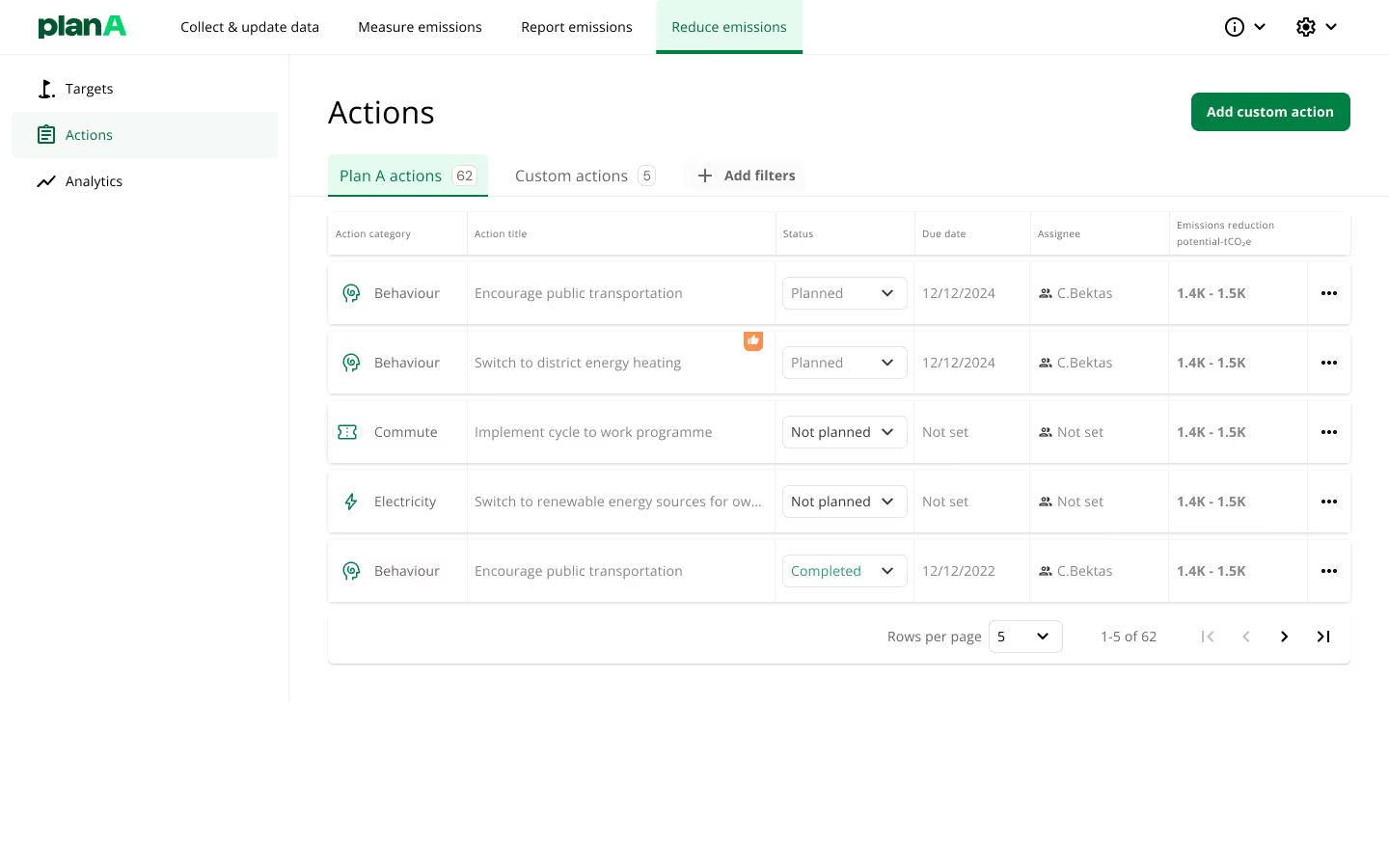After collecting data, calculating emissions, and setting ambitious targets, your company is ready to take the crucial next step: decarbonising its operations. Reducing your company’s carbon footprint is where your sustainability journey begins, translating strategic plans into impactful actions.
Decarbonisation is a a strategic business move, offering cost savings, increased credibility, and long-term resilience. With your foundation laid, it's time to dive into the practical measures that will drive actual reduction actions and position your company as a leader in sustainability.
The business benefits of reducing your company’s carbon footprint
Reducing your company's carbon footprint benefits the environment and brings significant business advantages. Here’s how decarbonisation can positively impact your bottom line and reduce costs.

How to identify and implement accurate reduction actions?
To effectively decarbonise, companies must first identify the largest source of emissions within their operations and supply chain. This allows them to prioritise and implement reduction strategies with the most significant potential impact on their corporate carbon footprint (CCF).
Once you have a complete overview of your CCF, you should prioritise your action reduction focus. Select the three emission categories with the highest GHG emissions. For each category, try to understand the primary source of the high emissions and which stakeholders can address these sources.

Credit: Unsplash
You can ask the following questions to identify relevant reduction actions:
- Business travel emissions:
- What is the share of flight trips?
- Which journeys were the most frequent and why?
- Which team travelled the most and why?
- Can some trips be phased out without impacting the business operations?
- Purchased goods and services emissions:
- Which purchase category had the highest impact on these emissions?
- Which spending can be reduced?
- Are the current suppliers committed to reducing GHG emissions?
- Do I have a procurement policy in place?
- Do I have a supplier code of conduct in place?
Tools for identifying potential reduction actions
As your organisation moves towards reducing its emissions, identifying and implementing potential reduction actions is a critical component of your decarbonisation strategy.
By systematically addressing the questions outlined below, you can assess your current initiatives, identify areas for improvement, and ensure that your efforts contribute to a significant reduction in GHG emissions. This introspective approach refines your strategy and ensures that every step you take is geared towards reducing your company's carbon footprint and aligning with global climate objectives.

Credit: Plan A
Let's explore the essential considerations and actions that can help drive your organisation towards its decarbonisation targets.
- Have I identified all potential actions that could contribute to my decarbonisation strategy?
- Have I evaluated whether implementing the action plan should allow me to achieve my strategic goals?
- Am I taking action to improve the carbon performance of my emitting assets?
- Am I taking action to increase the share of my CAPEX dedicated to low-carbon investments?
- Am I taking action to increase my R&D investments in climate change mitigation technologies?
- Am I carrying out interventions on my products to improve their carbon performance?
- Am I carrying out concrete actions to engage the suppliers to reduce their GHG emissions?
- Am I supporting any trade associations that have climate-negative activities or positions?
- Am I effectively developing business models that contribute to the low-carbon economy?
By thoroughly addressing these critical questions, you can ensure that your actions are practical and strategically aligned with your broader environmental objectives. Moving forward, continue scrutinising and adapting your strategies to substantially reduce GHG emissions and position your company as a sustainability leader.
Examples of emission reduction strategies for your company
Energy efficiency
Companies can significantly reduce emissions and costs by improving energy efficiency. The International Energy Agency (IEA) estimates that energy efficiency measures could lead to a 40% reduction in global CO2 emissions by 2040.
Renewable energy transition
Companies can transition to renewable energy sources like solar, wind, and hydro.
Circular economy and waste reduction
A circular economy emphasises waste reduction, reuse, and recycling. The Ellen MacArthur Foundation estimates that adopting circular economy principles could reduce global CO2 emissions by 3.7 billion tons annually by 2050.
Monitoring and reporting progress

Effective monitoring and reporting are vital to the success of any decarbonisation strategy. Clearly defining each action's parameters is essential to ensure that your decarbonisation actions are impactful and aligned with your strategic goals. Monitoring emissions involves identifying the strategic pillars they address, setting specific emissions reduction targets, and establishing relevant Key Performance Indicators (KPIs).
Additionally, understanding the resources, timelines, and stakeholder involvement necessary for each action will help in planning and implementation. Following a structured approach, you can systematically track progress and make informed adjustments to your strategy as needed.
For each decarbonisation action of your action plan, you should define:
- The related strategic pillar (e.g., business travel, energy, transportation of goods, etc.)
- If relevant, the related target of emissions reduction
- The related relevant unit and KPI
- The related base year and target year for the complete implementation of the action
- Which internal team will be accountable for coordinating and organising the implementation of the action
- Resources and time required for planning and implementation
- A global budget for planning and implementation
- Sources of financial support
- Involved stakeholders
- Level of involvement required
To assess the feasibility and coherence with climate considerations of your action plan, you can consider the following validation criteria (CLIMATE-SMART) for each decarbonisation action:
- Specific: What needs to be accomplished? Who’s responsible for it? What steps need to be taken to achieve it?
- Measurable: Specificity is a solid start, but quantifying your goals makes tracking progress easier and helps you know when you’ve reached the finish line.
- Achievable: Is your objective something your team can reasonably accomplish?
- Relevant: Why are you setting the goal that you’re setting?
- (Based on) Timeline: What’s your time horizon? When will the team start creating and implementing the tasks they’ve identified? When will they finish?
- (Impact on) Climate: Will the action lead to a low, medium, or high reduction in GHG emissions?
- Acceptable: Is the behavioural change required by the action acceptable for the target Stakeholders?
- Transformative: Will the action produce some type of business transformation?
- Engaging: Will this action favour the engagement of the target stakeholders?
By meticulously defining and tracking each decarbonisation action, you can ensure that your efforts are practical and aligned with your overall climate goals. Using the CLIMATE-SMART criteria, you can validate the feasibility and coherence of your action plan, ensuring each step is specific, measurable, achievable, relevant, and time-bound while also considering its climate impact and stakeholder engagement.
Now that you've taken significant steps to reduce your company’s carbon footprint, it's time to focus on the next phase: regularly refining and improving your decarbonisation strategy. This ongoing process is crucial for learning from past experiences, addressing new challenges, and seizing emerging opportunities. Think of it like training for a marathon—consistent effort and continuous improvement are crucial to success. Discover more about how to advance your decarbonisation strategy in our following guide.




.jpg)


.webp)


